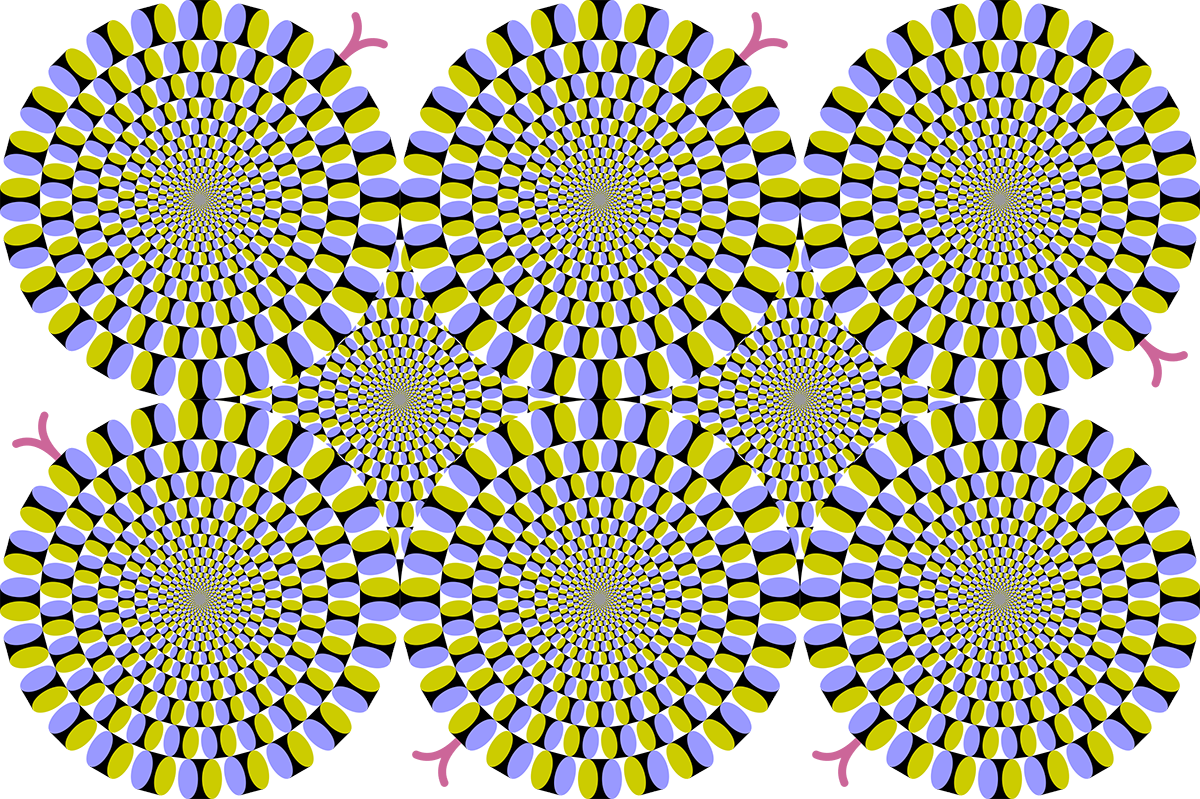In Head Trip, PopSci explores the relationship between our brains, our senses, and the strange things that happen in between.
Any cat owner knows how much our feline friends seem to bask in the coziness of a box. In fact, cats appear to derive so much comfort from enclosed spaces that their fondness for boxes extends to spaces that have no actual walls–and spaces whose “edges” are visual illusions. This curious phenomenon demonstrates potential similarities in cat/human sensory experience, and also ties into a larger conversation about how we can understand what goes on inside our mysterious pets’ little heads.
Edges are important–to humans and cats
You probably wouldn’t guess that the ability to recognize edges is critical to our survival, but being able to do so means also being able to identify shapes. That, in turn, allows distinguishing one object from another. This includes both possible threats and possible refuges from those threats.
This facility for edge recognition is just as important to animals as it is to us. “Boundaries are very important [to] any living being, to know when you’re going to walk into something or off a ledge,” animal cognitive researcher Gabriella Smith tells PopSci.
Thankfully, our brains are hardwired to recognize edges. But that also means we are susceptible to seeing edges that aren’t real. A classic example of such an illusion is Kanisza shapes, where illusory contours appear to define a shape that isn’t there. And we’re not alone: animals seem to be fooled in the same way—suggesting that their edge recognition facilities work in essentially the same way ours do.
Smith’s 2021 paper “If It Fits I Sits: A citizen science investigation into illusory contour susceptibility in domestic cats” explores how cats, in particular, have an affinity for boxy Kanisza shapes. They respond to these shapes exactly as one might expect—they sit in them.
What are Kanisza shapes?
At the most basic level, we recognize an edge as a place in our field of vision where there’s a sharp change in luminance or brightness. Even if two shapes are not distinguished by different colors or textures, you can tell one from the other if they differ in brightness. The transition in brightness between the two shapes is what we recognize as an edge–a visual signal that one shape ends and another begins.
So why do we see “edges” in Kanisza shapes? According to a 2018 study, Kanisza shapes fool our edge detection abilities by way of two phenomena—illusory contours and amodal completion—both of whose neural mechanisms are still being studied. As observed in a Kanisza “triangle” below, although a complete outline of a triangle is not depicted, our brains interpret that there is a whole triangle (with edges!) floating in the white, blank space in between the obviously PacMan-esque, round forms and the narrow Vs. That “triangle” is white as well, but it appears to be just a little brighter than its imaginary background. Seeing what the study calls a “luminance contrast edge” where there isn’t one is an example of illusory contours.
An amodal completion, on the other hand, is when “one object is interpreted as being behind another object even though only fragments of it are visible.” In this case, the three Vs are not connected, but our brains imagine that there are additional three lines completing their singular shape. The “completed” shape appears to be blocked by something–which is why only the V corners are visible; the rest of the shape must be hiding behind something else. That something else is, of course, that same “brighter” shape we described earlier–the Kaniza “triangle” with its illusory contours. (If you think about it, you don’t even need the Vs at all. The PacMan shapes alone already help the mechanism of amodal completion, looking like three black circles partially blocked by the three corners of our imaginary, “brighter” Kanisza triangle.)

Why do cats love sitting in boxes?
As animals that are both ambush predators and potential prey for larger hunters, cats generally dislike being exposed—being visible both detracts from their own ability to hunt and makes them vulnerable to ending up as someone else’s dinner. This goes a long way toward explaining their tendency to favor enclosed spaces, and a cozy cardboard box often fits the bill perfectly. A 2014 study deduced that shelter cats specifically adapted better to new environments better and appeared less stressed when they had a box to hide in.
The transition from an open, exposed area to a safe, enclosed one is defined by an edge. Smith’s study was prompted by the #catsquare trend on Twitter, where cat owners posted pictures of their feline friends sitting happily in taped squares on the floor. She wondered if cats would also be inclined to sit in spaces defined by illusory contours. If so, it would be pretty compelling evidence that cats saw those illusory contours as edges, just like we do.
So pleased to announce that my paper, “If I Fits I Sits: A Citizen Science Investigation into Illusory Contour Susceptibility in Domestic Cats (Felis silvestris catus) has just been published in AABS! #IfIFitsISits #CatSquare #CitizenScience #CommunityScience pic.twitter.com/AXbDttnOGC
— Gabriella E. Smith M.A. (@Explanimals) May 4, 2021
It appears that they can, indeed, the paper concludes: “The cats in this study stood or sat in the Kanizsa and square stimuli more often than the Kanizsa control, revealing susceptibility to illusory contours and supporting our hypothesis that cats treat an illusory square as they do a real square.” (As depicted in the video above, a cat may only need four white circles that appear to be blocked by a blue square between them on a similarly blue floor.)
The mysteries of pets’ perception
However, the fact that cats and humans see similar things doesn’t mean they experience what they see in the same manner. When we look at a Kanisza square, we know what we’re seeing isn’t real. Do cats understand this too?
This boils down to a question about animal consciousness—a notoriously difficult subject, for the simple reason that we can never experience the world the way other creatures do, and they can never describe their experiences to us. (As Smith observes dryly, “The question of consciousness is a sticky one.”) Depending on how you approach what “consciousness” even means, examining the nature of animal consciousness can be more a question of philosophy than anything else.As Smith says, “I have philosopher friends who describe ‘consciousness’ one way, and I know practical researchers who define it differently.”
When citizen science will do (and when it won’t)
It turns out that there are more oblique ways to look for answers. In the case of how cats experience illusory boxes versus real ones, Smith says that “it makes a lot of sense that a cat would get into a box with sides; it makes a lot less sense that [they’d] get into a box with no sides. So the way to quantify [the difference in how they experience each ‘box’] would be to look at, say, how long they stay in each. Just based on observing my own cat, I would expect her to spend more time in a box with sides versus one without.”
This method is imperfect, clearly—Smith, whose PhD research focuses on animal curiosity, cites the example of how “all animals are curious, but some seem more curious than others, because of just how comfortable they are in expressing it. Sometimes you’ll have a very nervous animal, but … we can’t [conclude] that they’re not curious because we don’t know what they’re [feeling] inside.” But it’s the best we’ve got, and Smith’s paper is an example of how it can yield some fascinating results.
Smith says that extending this sort of research beyond the researchers’ own animals often relies on citizen science—which comes with its own challenges. For instance, in 2022 Smith published a paper on the results of an experiment that explored animals’ reactions to the rotating snake illusion. The rotating snake illusion is an example of a peripheral drift induced by repeating, asymmetric luminance patterns. While these patterns do not move, they appear to rotate the minute you are not staring at them directly. The trick relies on microsaccadic eye movements–involuntary, quick jerks in focus… in humans. “There was preliminary evidence from a zoo, suggesting that some of its lions saw the illusion,” she recalls.

There was enough data to pique her interest, and she and her colleagues set out to explore how domestic animals would react to that illusion. “[We] and I sent rotating snake stimuli and two different controls to both cat and dog owners to [place] on the ground in their homes to see how their pets reacted,” she recalls.
However, in what will come as absolutely no surprise to cat owners, the cats proved less than co-operative. “They really didn’t behave in the way that we expected!” Smith laughs ruefully. “The dogs spent more time at one of the controls. But to me [even] that looks like a fluke. There are always these open questions with citizen science and community science, about [how] to make things more cohesive and replicable.”
Cats will be cats
Of course, it could well be that both sets of animals did see the illusion and simply shrugged their collective furry shoulders at it. As someone who’s spent a perhaps unwise amount of time around cats, I’ve observed myself that kittens will often freak out when they first catch sight of themselves or one of their litter-mates in a mirror—but they also conclude pretty quickly that as they can’t smell or interact with the weird impostor, it’s no fun and not worth worrying about. Similarly, the cats in this video appear mildly interested in an illusory hole, but only briefly. (It’s interesting to compare their reaction to that of two otters presented with the same illusion.)
This brings us back to the fundamental difficulty of having to rely on deducing the answers from animals’ actions. Are cats really responding to the lure of an imaginary box with imaginary edges? Can they “see” the “edges”? Do they realize the “edges” aren’t really there? Do they care? Life would be a lot more straightforward if we could just ask our feline friends what they see when they look at an illusion. Or perhaps not: cats being cats, there’s no guarantee they’d answer anyway.





